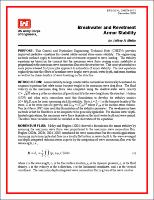Please use this identifier to cite or link to this item:
https://hdl.handle.net/11681/1929Full metadata record
| DC Field | Value | Language |
|---|---|---|
| dc.contributor.author | Melby, Jeffrey A. | - |
| dc.date.accessioned | 2016-03-11T00:00:11Z | - |
| dc.date.available | 2016-03-11T00:00:11Z | - |
| dc.date.issued | 2005-12 | - |
| dc.identifier.uri | http://hdl.handle.net/11681/1929 | - |
| dc.description | Technical note | - |
| dc.description | PURPOSE: This Coastal and Hydraulics Engineering Technical Note (CHETN) provides improved predictive equations for coastal rubble-mound stone-armor stability. The engineering methods outlined apply to breakwaters and revetments exposed to wave loading. The stability equations are based on the concept that the maximum wave force causing armor instability is proportional to the maximum wave momentum flux near the structure toe. This concept introduces a more physics-based first principles approach to estimation of armor stability. The new equations explicitly include the effects of nearshore wave height, wave period, water depth, and storm duration as well as the characteristics of wave breaking on the structure. | - |
| dc.publisher | Coastal and Hydraulics Laboratory (U.S.) | - |
| dc.publisher | Engineer Research and Development Center (U.S.) | - |
| dc.relation | http://acwc.sdp.sirsi.net/client/en_US/search/asset/1000378 | - |
| dc.relation.ispartofseries | Technical note (Coastal and Hydraulics Engineering) ; III-71. | - |
| dc.rights | Approved for public release; distribution is unlimited. | - |
| dc.source | This Digital Resource was created from scans of the Print Resource. | - |
| dc.subject | Armor stability | - |
| dc.subject | Breakwater | - |
| dc.subject | Nearshore wave height | - |
| dc.subject | Storm | - |
| dc.subject | Water depth | - |
| dc.subject | Wave momentum flux | - |
| dc.subject | Wave period | - |
| dc.title | Breakwater and revetment armor stability | - |
| dc.type | Report | en_US |
| Appears in Collections: | Technical Note | |
Files in This Item:
| File | Description | Size | Format | |
|---|---|---|---|---|
| CHETN-III-71.pdf | 252.89 kB | Adobe PDF |  View/Open |